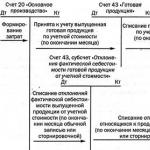The focus of this article is logarithm. Here we will give a definition of a logarithm, show the accepted notation, give examples of logarithms, and talk about natural and decimal logarithms. After this we will consider the basic logarithmic identity.
Page navigation.
Definition of logarithm
The concept of a logarithm arises when solving a problem in a certain inverse sense, when you need to find an exponent from a known exponent value and a known base.
But enough prefaces, it’s time to answer the question “what is a logarithm”? Let us give the corresponding definition.
Definition.
Logarithm of b to base a, where a>0, a≠1 and b>0 is the exponent to which you need to raise the number a to get b as a result.
At this stage, we note that the spoken word “logarithm” should immediately raise two follow-up questions: “what number” and “on what basis.” In other words, there is simply no logarithm, but only the logarithm of a number to some base.
Let's enter right away logarithm notation: the logarithm of a number b to base a is usually denoted as log a b. The logarithm of a number b to base e and the logarithm to base 10 have their own special designations lnb and logb, respectively, that is, they write not log e b, but lnb, and not log 10 b, but lgb.
Now we can give: .
And the records  do not make sense, since in the first of them there is a negative number under the logarithm sign, in the second there is a negative number in the base, and in the third there is a negative number under the logarithm sign and a unit in the base.
do not make sense, since in the first of them there is a negative number under the logarithm sign, in the second there is a negative number in the base, and in the third there is a negative number under the logarithm sign and a unit in the base.
Now let's talk about rules for reading logarithms. Log a b is read as "the logarithm of b to base a". For example, log 2 3 is the logarithm of three to the base 2, and is the logarithm of two point two thirds to the base square root of five. The logarithm to base e is called natural logarithm, and the notation lnb reads "natural logarithm of b". For example, ln7 is the natural logarithm of seven, and we will read it as the natural logarithm of pi. The base 10 logarithm also has a special name - decimal logarithm, and lgb is read as "decimal logarithm of b". For example, lg1 is the decimal logarithm of one, and lg2.75 is the decimal logarithm of two point seven five hundredths.
It is worth dwelling separately on the conditions a>0, a≠1 and b>0, under which the definition of the logarithm is given. Let us explain where these restrictions come from. An equality of the form called , which directly follows from the definition of logarithm given above, will help us do this.
Let's start with a≠1. Since one to any power is equal to one, the equality can only be true when b=1, but log 1 1 can be any real number. To avoid this ambiguity, a≠1 is assumed.
Let us justify the expediency of the condition a>0. With a=0, by the definition of a logarithm, we would have equality, which is only possible with b=0. But then log 0 0 can be any non-zero real number, since zero to any non-zero power is zero. The condition a≠0 allows us to avoid this ambiguity. And when a<0 нам бы пришлось отказаться от рассмотрения рациональных и иррациональных значений логарифма, так как степень с рациональным и иррациональным показателем определена лишь для неотрицательных оснований. Поэтому и принимается условие a>0 .
Finally, the condition b>0 follows from the inequality a>0, since , and the value of a power with a positive base a is always positive.
To conclude this point, let’s say that the stated definition of the logarithm allows you to immediately indicate the value of the logarithm when the number under the logarithm sign is a certain power of the base. Indeed, the definition of a logarithm allows us to state that if b=a p, then the logarithm of the number b to base a is equal to p. That is, the equality log a a p =p is true. For example, we know that 2 3 =8, then log 2 8=3. We will talk more about this in the article.
Logarithm of a number N based on A called exponent X , to which you need to build A to get the number N
Provided that  ,
, ,
,

From the definition of logarithm it follows that  , i.e.
, i.e.
 - this equality is the basic logarithmic identity.
- this equality is the basic logarithmic identity.
Logarithms to base 10 are called decimal logarithms. Instead of  write
write  .
.
Logarithms to the base e
are called natural and are designated  .
.
Basic properties of logarithms.
The logarithm of one is equal to zero for any base.

The logarithm of the product is equal to the sum of the logarithms of the factors.
3) The logarithm of the quotient is equal to the difference of the logarithms



Factor  called the modulus of transition from logarithms to the base a
to logarithms at the base b
.
called the modulus of transition from logarithms to the base a
to logarithms at the base b
.
Using properties 2-5, it is often possible to reduce the logarithm of a complex expression to the result of simple arithmetic operations on logarithms.
For example, 
Such transformations of a logarithm are called logarithms. Transformations inverse to logarithms are called potentiation.
Chapter 2. Elements of higher mathematics.
1. Limits
Limit of the function  is a finite number A if, as xx
0
for each predetermined
is a finite number A if, as xx
0
for each predetermined  , there is such a number
, there is such a number  that as soon as
that as soon as  , That
, That  .
.

A function that has a limit differs from it by an infinitesimal amount:  , where- b.m.v., i.e.
, where- b.m.v., i.e.  .
.
Example. Consider the function  .
.
When striving  , function y
tends to zero:
, function y
tends to zero: 
1.1. Basic theorems about limits.
The limit of a constant value is equal to this constant value
 .
.
The limit of the sum (difference) of a finite number of functions is equal to the sum (difference) of the limits of these functions.
The limit of the product of a finite number of functions is equal to the product of the limits of these functions.
The limit of the quotient of two functions is equal to the quotient of the limits of these functions if the limit of the denominator is not zero.

Wonderful Limits
 ,
,
 , Where
, Where 
1.2. Limit Calculation Examples

However, not all limits are calculated so easily. More often, calculating the limit comes down to revealing an uncertainty of the type:  or .
or .
 .
.
2. Derivative of a function
Let us have a function  , continuous on the segment
, continuous on the segment  .
.
Argument  got some increase
got some increase  . Then the function will receive an increment
. Then the function will receive an increment  .
.
Argument value  corresponds to the function value
corresponds to the function value  .
.
Argument value  corresponds to the function value.
corresponds to the function value.
Hence, .

Let us find the limit of this ratio at  . If this limit exists, then it is called the derivative of the given function.
. If this limit exists, then it is called the derivative of the given function.


Definition 3 Derivative of a given function 
 by argument
by argument  is called the limit of the ratio of the increment of a function to the increment of the argument, when the increment of the argument arbitrarily tends to zero.
is called the limit of the ratio of the increment of a function to the increment of the argument, when the increment of the argument arbitrarily tends to zero.
Derivative of a function  can be designated as follows:
can be designated as follows:
 ;
;
 ;
;
 ;
;
 .
.
Definition 4The operation of finding the derivative of a function is called differentiation.
2.1. Mechanical meaning of derivative.
Let's consider the rectilinear motion of some rigid body or material point.
Let at some point in time 
 moving point
moving point  was at a distance
was at a distance  from the starting position
from the starting position  .
.

After some period of time  she moved a distance
she moved a distance  . Attitude
. Attitude  =
= - average speed of a material point
- average speed of a material point  . Let us find the limit of this ratio, taking into account that
. Let us find the limit of this ratio, taking into account that  .
.
Consequently, determining the instantaneous speed of movement of a material point is reduced to finding the derivative of the path with respect to time.
2.2. Geometric value of the derivative
Let us have a graphically defined function  .
.

Rice. 1. Geometric meaning of derivative
If  , then point
, then point  , will move along the curve, approaching the point
, will move along the curve, approaching the point  .
.

Hence  , i.e. the value of the derivative for a given value of the argument
, i.e. the value of the derivative for a given value of the argument  numerically equal to the tangent of the angle formed by the tangent at a given point with the positive direction of the axis
numerically equal to the tangent of the angle formed by the tangent at a given point with the positive direction of the axis  .
.
2.3. Table of basic differentiation formulas.
Power function
|
|
|
|
|
|
|
Exponential function
|
|
|
|
|
Logarithmic function
|
|
|
|
|
Trigonometric function
|
|
|
|
|
|
|
|
|
|
Inverse trigonometric function
|
|
|
|
|
|
|
|
|
|
2.4. Rules of differentiation.
Derivative of 

Derivative of the sum (difference) of functions


Derivative of the product of two functions


Derivative of the quotient of two functions


2.5. Derivative of a complex function.
Let the function be given  such that it can be represented in the form
such that it can be represented in the form
 And
And  , where the variable
, where the variable  is an intermediate argument, then
is an intermediate argument, then 
The derivative of a complex function is equal to the product of the derivative of the given function with respect to the intermediate argument and the derivative of the intermediate argument with respect to x.
Example 1. 

Example 2. 

3. Differential function.
Let there be  , differentiable on some interval
, differentiable on some interval  let it go at
this function has a derivative
let it go at
this function has a derivative
 ,
,
then we can write
 (1),
(1),
Where  - an infinitesimal quantity,
- an infinitesimal quantity,
since when 
Multiplying all terms of equality (1) by  we have:
we have:
Where  - b.m.v. higher order.
- b.m.v. higher order.
Magnitude  called the differential of the function
called the differential of the function  and is designated
and is designated 
 .
.
3.1. Geometric value of the differential.
Let the function be given  .
.

Fig.2. Geometric meaning of differential.
 .
.
Obviously, the differential of the function  is equal to the increment of the ordinate of the tangent at a given point.
is equal to the increment of the ordinate of the tangent at a given point.
3.2. Derivatives and differentials of various orders.
If there  , Then
, Then  is called the first derivative.
is called the first derivative.
The derivative of the first derivative is called the second-order derivative and is written  .
.
Derivative of the nth order of the function  is called the (n-1)th order derivative and is written:
is called the (n-1)th order derivative and is written:
 .
.
The differential of the differential of a function is called the second differential or second order differential.
 .
.

 .
.
3.3 Solving biological problems using differentiation.
Task 1. Studies have shown that the growth of a colony of microorganisms obeys the law  , Where N
– number of microorganisms (in thousands), t
– time (days).
, Where N
– number of microorganisms (in thousands), t
– time (days).
b) Will the population of the colony increase or decrease during this period?
Answer. The size of the colony will increase.
Task 2. The water in the lake is periodically tested to monitor the content of pathogenic bacteria. Through t days after testing, the concentration of bacteria is determined by the ratio
 .
.
When will the lake have a minimum concentration of bacteria and will it be possible to swim in it?
Solution: A function reaches max or min when its derivative is zero.
 ,
,
Let's determine the max or min will be in 6 days. To do this, let's take the second derivative.


Answer: After 6 days there will be a minimum concentration of bacteria.
Today we will talk about logarithmic formulas and we will give indicative solution examples.
They themselves imply solution patterns according to the basic properties of logarithms. Before applying logarithm formulas to solve, let us remind you of all the properties:
Now, based on these formulas (properties), we will show examples of solving logarithms.
Examples of solving logarithms based on formulas.
Logarithm a positive number b to base a (denoted by log a b) is an exponent to which a must be raised to get b, with b > 0, a > 0, and 1.
According to the definition, log a b = x, which is equivalent to a x = b, therefore log a a x = x.
Logarithms, examples:
log 2 8 = 3, because 2 3 = 8
log 7 49 = 2, because 7 2 = 49
log 5 1/5 = -1, because 5 -1 = 1/5
Decimal logarithm- this is an ordinary logarithm, the base of which is 10. It is denoted as lg.
log 10 100 = 2, because 10 2 = 100
Natural logarithm- also an ordinary logarithm, a logarithm, but with the base e (e = 2.71828... - an irrational number). Denoted as ln.
It is advisable to memorize the formulas or properties of logarithms, because we will need them later when solving logarithms, logarithmic equations and inequalities. Let's work through each formula again with examples.
- Basic logarithmic identity
a log a b = b8 2log 8 3 = (8 2log 8 3) 2 = 3 2 = 9
- The logarithm of the product is equal to the sum of the logarithms
log a (bc) = log a b + log a clog 3 8.1 + log 3 10 = log 3 (8.1*10) = log 3 81 = 4
- The logarithm of the quotient is equal to the difference of the logarithms
log a (b/c) = log a b - log a c9 log 5 50 /9 log 5 2 = 9 log 5 50- log 5 2 = 9 log 5 25 = 9 2 = 81
- Properties of the power of a logarithmic number and the base of the logarithm
Exponent of the logarithmic number log a b m = mlog a b
Exponent of the base of the logarithm log a n b =1/n*log a b
log a n b m = m/n*log a b,
if m = n, we get log a n b n = log a b
log 4 9 = log 2 2 3 2 = log 2 3
- Transition to a new foundation
log a b = log c b/log c a,if c = b, we get log b b = 1
then log a b = 1/log b a
log 0.8 3*log 3 1.25 = log 0.8 3*log 0.8 1.25/log 0.8 3 = log 0.8 1.25 = log 4/5 5/4 = -1
As you can see, the formulas for logarithms are not as complicated as they seem. Now, having looked at examples of solving logarithms, we can move on to logarithmic equations. We will look at examples of solving logarithmic equations in more detail in the article: "". Do not miss!
If you still have questions about the solution, write them in the comments to the article.
Note: we decided to get a different class of education and study abroad as an option.
The logarithm of a positive number b to base a (a>0, a is not equal to 1) is a number c such that a c = b: log a b = c ⇔ a c = b (a > 0, a ≠ 1, b > 0)
Note that the logarithm of a non-positive number is undefined. In addition, the base of the logarithm must be a positive number that is not equal to 1. For example, if we square -2, we get the number 4, but this does not mean that the logarithm to the base -2 of 4 is equal to 2.
Basic logarithmic identity
a log a b = b (a > 0, a ≠ 1) (2)It is important that the scope of definition of the right and left sides of this formula is different. The left side is defined only for b>0, a>0 and a ≠ 1. The right side is defined for any b, and does not depend on a at all. Thus, the application of the basic logarithmic “identity” when solving equations and inequalities can lead to a change in the OD.
Two obvious consequences of the definition of logarithm
log a a = 1 (a > 0, a ≠ 1) (3)log a 1 = 0 (a > 0, a ≠ 1) (4)
Indeed, when raising the number a to the first power, we get the same number, and when raising it to the zero power, we get one.
Logarithm of the product and logarithm of the quotient
log a (b c) = log a b + log a c (a > 0, a ≠ 1, b > 0, c > 0) (5)Log a b c = log a b − log a c (a > 0, a ≠ 1, b > 0, c > 0) (6)
I would like to warn schoolchildren against thoughtlessly using these formulas when solving logarithmic equations and inequalities. When using them “from left to right,” the ODZ narrows, and when moving from the sum or difference of logarithms to the logarithm of the product or quotient, the ODZ expands.
Indeed, the expression log a (f (x) g (x)) is defined in two cases: when both functions are strictly positive or when f(x) and g(x) are both less than zero.
Transforming this expression into the sum log a f (x) + log a g (x), we are forced to limit ourselves only to the case when f(x)>0 and g(x)>0. There is a narrowing of the range of acceptable values, and this is categorically unacceptable, since it can lead to a loss of solutions. A similar problem exists for formula (6).
The degree can be taken out of the sign of the logarithm
log a b p = p log a b (a > 0, a ≠ 1, b > 0) (7)And again I would like to call for accuracy. Consider the following example:
Log a (f (x) 2 = 2 log a f (x)
The left side of the equality is obviously defined for all values of f(x) except zero. The right side is only for f(x)>0! By taking the degree out of the logarithm, we again narrow the ODZ. The reverse procedure leads to an expansion of the range of acceptable values. All these remarks apply not only to power 2, but also to any even power.
Formula for moving to a new foundation
log a b = log c b log c a (a > 0, a ≠ 1, b > 0, c > 0, c ≠ 1) (8)That rare case when the ODZ does not change during transformation. If you have chosen base c wisely (positive and not equal to 1), the formula for moving to a new base is completely safe.
If we choose the number b as the new base c, we obtain an important special case of formula (8):
Log a b = 1 log b a (a > 0, a ≠ 1, b > 0, b ≠ 1) (9)
Some simple examples with logarithms
Example 1. Calculate: log2 + log50.
Solution. log2 + log50 = log100 = 2. We used the sum of logarithms formula (5) and the definition of the decimal logarithm.
Example 2. Calculate: lg125/lg5.
Solution. log125/log5 = log 5 125 = 3. We used the formula for moving to a new base (8).
Table of formulas related to logarithms
| a log a b = b (a > 0, a ≠ 1) |
| log a a = 1 (a > 0, a ≠ 1) |
| log a 1 = 0 (a > 0, a ≠ 1) |
| log a (b c) = log a b + log a c (a > 0, a ≠ 1, b > 0, c > 0) |
| log a b c = log a b − log a c (a > 0, a ≠ 1, b > 0, c > 0) |
| log a b p = p log a b (a > 0, a ≠ 1, b > 0) |
| log a b = log c b log c a (a > 0, a ≠ 1, b > 0, c > 0, c ≠ 1) |
| log a b = 1 log b a (a > 0, a ≠ 1, b > 0, b ≠ 1) |
We continue to study logarithms. In this article we will talk about calculating logarithms, this process is called logarithm. First we will understand the calculation of logarithms by definition. Next, let's look at how the values of logarithms are found using their properties. After this, we will focus on calculating logarithms through the initially specified values of other logarithms. Finally, let's learn how to use logarithm tables. The entire theory is provided with examples with detailed solutions.
Page navigation.
Calculating logarithms by definition
In the simplest cases it is possible to perform quite quickly and easily finding the logarithm by definition. Let's take a closer look at how this process happens.
Its essence is to represent the number b in the form a c, from which, by the definition of a logarithm, the number c is the value of the logarithm. That is, by definition, the following chain of equalities corresponds to finding the logarithm: log a b=log a a c =c.
So, calculating a logarithm by definition comes down to finding a number c such that a c = b, and the number c itself is the desired value of the logarithm.
Taking into account the information in the previous paragraphs, when the number under the logarithm sign is given by a certain power of the logarithm base, you can immediately indicate what the logarithm is equal to - it is equal to the exponent. Let's show solutions to examples.
Example.
Find log 2 2 −3, and also calculate the natural logarithm of the number e 5,3.
Solution.
The definition of the logarithm allows us to immediately say that log 2 2 −3 =−3. Indeed, the number under the logarithm sign is equal to base 2 to the −3 power.
Similarly, we find the second logarithm: lne 5.3 =5.3.
Answer:
log 2 2 −3 =−3 and lne 5,3 =5,3.
If the number b under the logarithm sign is not specified as a power of the base of the logarithm, then you need to carefully look to see if it is possible to come up with a representation of the number b in the form a c . Often this representation is quite obvious, especially when the number under the logarithm sign is equal to the base to the power of 1, or 2, or 3, ...
Example.
Calculate the logarithms log 5 25 , and .
Solution.
It is easy to see that 25=5 2, this allows you to calculate the first logarithm: log 5 25=log 5 5 2 =2.
Let's move on to calculating the second logarithm. The number can be represented as a power of 7:  (see if necessary). Hence,
(see if necessary). Hence,  .
.
Let's rewrite the third logarithm in the following form. Now you can see that  , from which we conclude that
, from which we conclude that  . Therefore, by the definition of logarithm
. Therefore, by the definition of logarithm  .
.
Briefly, the solution could be written as follows: .
Answer:
log 5 25=2 , ![]() And
And  .
.
When there is a sufficiently large natural number under the logarithm sign, it does not hurt to factor it into prime factors. It often helps to represent such a number as some power of the base of the logarithm, and therefore calculate this logarithm by definition.
Example.
Find the value of the logarithm.
Solution.
Some properties of logarithms allow you to immediately specify the value of logarithms. These properties include the property of the logarithm of one and the property of the logarithm of a number equal to the base: log 1 1=log a a 0 =0 and log a a=log a a 1 =1. That is, when under the sign of the logarithm there is a number 1 or a number a equal to the base of the logarithm, then in these cases the logarithms are equal to 0 and 1, respectively.
Example.
What are logarithms and log10 equal to?
Solution.
Since , then from the definition of logarithm it follows ![]() .
.
In the second example, the number 10 under the logarithm sign coincides with its base, so the decimal logarithm of ten is equal to one, that is, lg10=lg10 1 =1.
Answer:
AND lg10=1 .
Note that the calculation of logarithms by definition (which we discussed in the previous paragraph) implies the use of the equality log a a p =p, which is one of the properties of logarithms.
In practice, when a number under the logarithm sign and the base of the logarithm are easily represented as a power of a certain number, it is very convenient to use the formula  , which corresponds to one of the properties of logarithms. Let's look at an example of finding a logarithm that illustrates the use of this formula.
, which corresponds to one of the properties of logarithms. Let's look at an example of finding a logarithm that illustrates the use of this formula.
Example.
Calculate the logarithm.
Solution.
Answer:
![]() .
.
Properties of logarithms not mentioned above are also used in calculations, but we will talk about this in the following paragraphs.
Finding logarithms through other known logarithms
The information in this paragraph continues the topic of using the properties of logarithms when calculating them. But here the main difference is that the properties of logarithms are used to express the original logarithm in terms of another logarithm, the value of which is known. Let's give an example for clarification. Let's say we know that log 2 3≈1.584963, then we can find, for example, log 2 6 by doing a little transformation using the properties of the logarithm: log 2 6=log 2 (2 3)=log 2 2+log 2 3≈ 1+1,584963=2,584963 .
In the above example, it was enough for us to use the property of the logarithm of a product. However, much more often it is necessary to use a wider arsenal of properties of logarithms in order to calculate the original logarithm through the given ones.
Example.
Calculate the logarithm of 27 to base 60 if you know that log 60 2=a and log 60 5=b.
Solution.
So we need to find log 60 27 . It is easy to see that 27 = 3 3 , and the original logarithm, due to the property of the logarithm of the power, can be rewritten as 3·log 60 3 .
Now let's see how to express log 60 3 in terms of known logarithms. The property of the logarithm of a number equal to the base allows us to write the equality log 60 60=1. On the other hand, log 60 60=log60(2 2 3 5)= log 60 2 2 +log 60 3+log 60 5= 2·log 60 2+log 60 3+log 60 5 . Thus, 2 log 60 2+log 60 3+log 60 5=1. Hence, log 60 3=1−2·log 60 2−log 60 5=1−2·a−b.
Finally, we calculate the original logarithm: log 60 27=3 log 60 3= 3·(1−2·a−b)=3−6·a−3·b.
Answer:
log 60 27=3·(1−2·a−b)=3−6·a−3·b.
Separately, it is worth mentioning the meaning of the formula for transition to a new base of the logarithm of the form  . It allows you to move from logarithms with any base to logarithms with a specific base, the values of which are known or it is possible to find them. Usually, from the original logarithm, using the transition formula, they move to logarithms in one of the bases 2, e or 10, since for these bases there are tables of logarithms that allow their values to be calculated with a certain degree of accuracy. In the next paragraph we will show how this is done.
. It allows you to move from logarithms with any base to logarithms with a specific base, the values of which are known or it is possible to find them. Usually, from the original logarithm, using the transition formula, they move to logarithms in one of the bases 2, e or 10, since for these bases there are tables of logarithms that allow their values to be calculated with a certain degree of accuracy. In the next paragraph we will show how this is done.
Logarithm tables and their uses
For approximate calculation of logarithm values can be used logarithm tables. The most commonly used base 2 logarithm table, natural logarithm table, and decimal logarithm table. When working in the decimal number system, it is convenient to use a table of logarithms based on base ten. With its help we will learn to find the values of logarithms.





The presented table allows you to find the values of the decimal logarithms of numbers from 1,000 to 9,999 (with three decimal places) with an accuracy of one ten-thousandth. We will analyze the principle of finding the value of a logarithm using a table of decimal logarithms using a specific example - it’s clearer this way. Let's find log1.256.
In the left column of the table of decimal logarithms we find the first two digits of the number 1.256, that is, we find 1.2 (this number is circled in blue for clarity). The third digit of the number 1.256 (digit 5) is found in the first or last line to the left of the double line (this number is circled in red). The fourth digit of the original number 1.256 (digit 6) is found in the first or last line to the right of the double line (this number is circled with a green line). Now we find the numbers in the cells of the logarithm table at the intersection of the marked row and marked columns (these numbers are highlighted in orange). The sum of the marked numbers gives the desired value of the decimal logarithm accurate to the fourth decimal place, that is, log1.236≈0.0969+0.0021=0.0990.
Is it possible, using the table above, to find the values of decimal logarithms of numbers that have more than three digits after the decimal point, as well as those that go beyond the range from 1 to 9.999? Yes, you can. Let's show how this is done with an example.
Let's calculate lg102.76332. First you need to write down number in standard form: 102.76332=1.0276332·10 2. After this, the mantissa should be rounded to the third decimal place, we have 1.0276332 10 2 ≈1.028 10 2, while the original decimal logarithm is approximately equal to the logarithm of the resulting number, that is, we take log102.76332≈lg1.028·10 2. Now we apply the properties of the logarithm: lg1.028·10 2 =lg1.028+lg10 2 =lg1.028+2. Finally, we find the value of the logarithm lg1.028 from the table of decimal logarithms lg1.028≈0.0086+0.0034=0.012. As a result, the entire process of calculating the logarithm looks like this: log102.76332=log1.0276332 10 2 ≈lg1.028 10 2 = log1.028+lg10 2 =log1.028+2≈0.012+2=2.012.
In conclusion, it is worth noting that using a table of decimal logarithms you can calculate the approximate value of any logarithm. To do this, it is enough to use the transition formula to go to decimal logarithms, find their values in the table, and perform the remaining calculations.
For example, let's calculate log 2 3 . According to the formula for transition to a new base of the logarithm, we have . From the table of decimal logarithms we find log3≈0.4771 and log2≈0.3010. Thus,  .
.
Bibliography.
- Kolmogorov A.N., Abramov A.M., Dudnitsyn Yu.P. and others. Algebra and the beginnings of analysis: Textbook for grades 10 - 11 of general education institutions.
- Gusev V.A., Mordkovich A.G. Mathematics (a manual for those entering technical schools).
















































